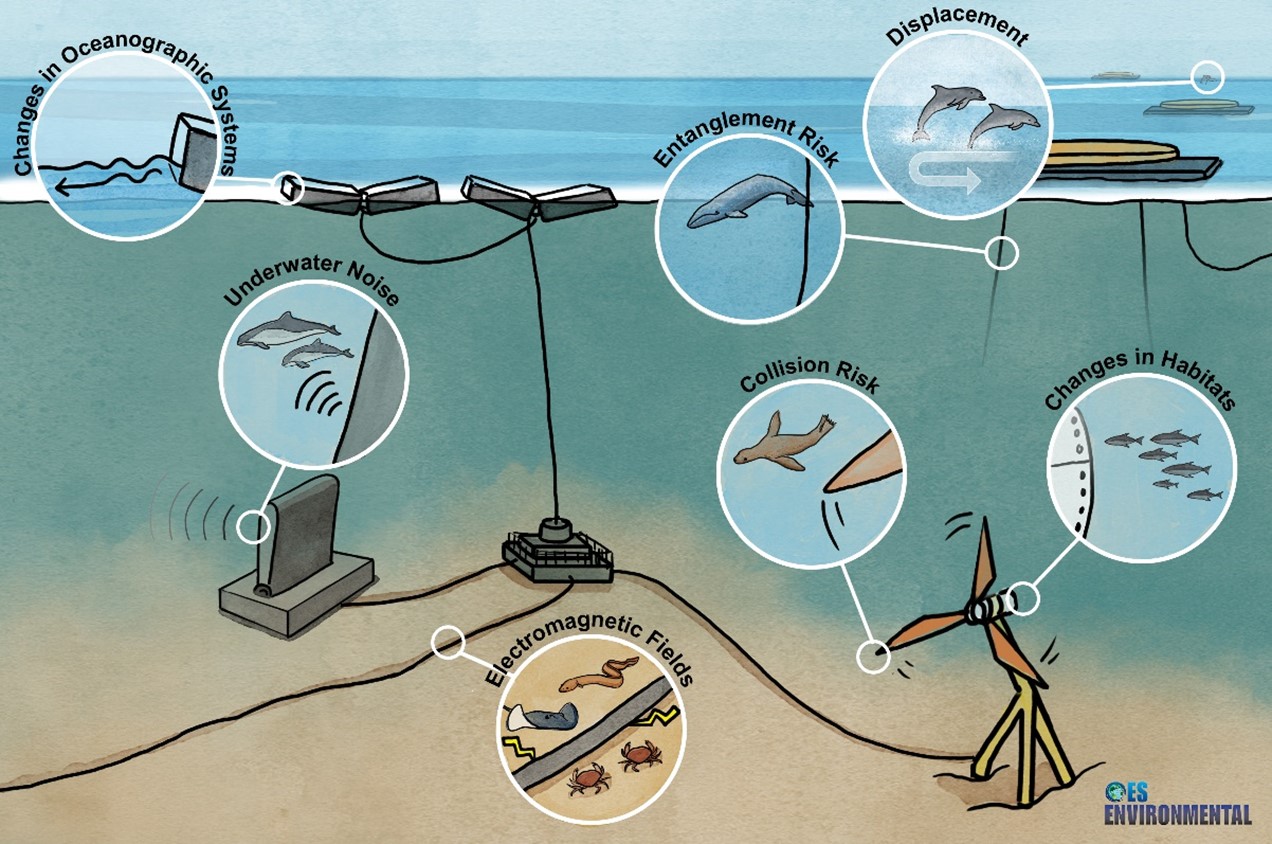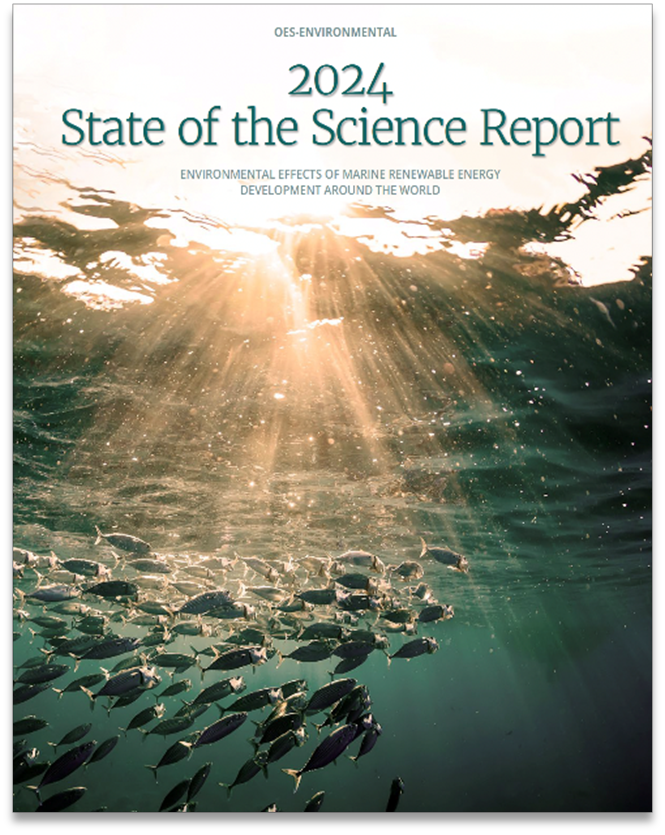In the search for renewable and sustainable energy solutions, estimates suggest that 80% of the world’s energy needs could be met with wind and solar energy. Marine renewable energy could potentially meet the remaining 20% of energy needs, particularly in those locations where other renewables are not well suited such as high latitudes or far out at sea. However, uncertainties remain about the potential effects on marine animals, habitats, and ecosystem processes.
2024 State of the Science Report
Ocean Energy Systems (OES)-Environmental released the 2024 State of the Science Report on 17 September 2024. The report brings together the most up-to-date information on the potential environmental effects of marine renewable energy development, shares helpful resources, and identifies a path forward to advance the marine renewable energy industry in a responsible manner. This report is a culmination of OES-Environmental Phase 4, a four-year effort spanning 2020-2024. OES-Environmental is an international initiative dedicated to understanding the environmental effects of marine renewable energy that includes representation from 16 nations. The 2024 report builds upon the 2020 State of the Science Report, the 2016 State of the Science Report, and the 2013 Final Report for Phase 1 of OES-Environmental.
The over 300-page 2024 State of the Science Report includes comprehensive information on the following topics:
- Marine renewable energy environmental effects (Sections A-B)
- Human dimensions (Section C)
- Marine renewable energy resources (Section D)
- Looking beyond stressor-receptor interactions (Section E)
- Scaling up to arrays, ecosystem approach, and cumulative effects (Chapter 9)
- Tropical and subtropical ecosystems (Chapter 10)
- Looking ahead (Section F)
- Summary and path forward (Chapter 11)
The report also includes an Executive Summary, available in eight languages (English, Chinese, French, Japanese, Portuguese, Norwegian, Spanish, and Swedish), and two-page short science summaries for most chapters.
Some key highlights from the report include:
- There is consensus that risks from small numbers of marine renewable energy devices (one to six) for changes in habitat, changes in oceanographic systems, underwater noise, and electromagnetic fields can be retired.
- While research has shown that marine animals are unlikely to collide with a tidal turbine, the low number of deployments and the challenges of collecting data limit our understanding of collision risk.
- OES-Environmental assessed social and economic effects of marine renewable energy in-depth for the first time in the report, in an effort to compile current knowledge on which groups might be affected by MRE development and how.
- Engaging stakeholders early in the planning and development process of marine renewable energy projects can help project developers understand and address stakeholder and community concerns and work toward community acceptance.
- Educational resources and outreach materials on the environmental effects of marine renewable energy are available to spread awareness about the benefits, challenges, and opportunities, and to aid workforce development.
- As the marine renewable energy industry expands to multiple devices and arrays and to tropical and subtropical regions, a system-wide effects approach is necessary to better understand potential environmental effects.
- Identifying environmental risks early, collaborating with researchers and communities, and promoting transparency in data accessibility will help move the marine renewable energy industry forward in a responsible manner.
Read the full report here or watch a webinar highlighting the key findings of the report here.

What’s next for OES-Environmental?
As Phase 4 of OES-Environmental comes to a close, some areas of uncertainty about environmental effects of marine renewable energy remain. A new phase has been authorized (Phase 5) that will span 2024-2028 and include continued efforts such as risk retirement and the development of new areas of research.
Four new areas of research will be investigated during Phase 5 of OES-Environmental. The compendium of knowledge acquired to date will be used to advise on environmental acceptability by examining potential risks devices might cause and guiding the development of recommendations on design, deployment, operation, maintenance, and decommissioning of marine renewable energy devices from an environmental perspective. There are many off-grid uses of marine renewable energy, including powering offshore aquaculture operations or remote areas and coastal islands. These alternative applications may have less or different environmental effects from grid-scale devices, so potential environmental effects of off-grid devices will be examined. Phase 5 will also include delving further into the potential system-wide effects of marine renewable energy as the industry scales up from single devices to larger arrays. This includes continuing to examine how marine renewable energy development may affect ecosystems, food webs, and other human uses of the ocean. In addition, there is a need to further explore potential social and economic effects of marine renewable energy development and how they relate to environmental effects. During Phase 5, OES-Environmental will examine how coastal communities and other stakeholders may be affected and develop best practices for assessing social and economic effects.
As Phase 5 begins, OES-Environmental continues to collaborate with OES countries to coordinate research that can progress the marine renewable energy industry in an environmentally responsible manner. There are currently 16 countries involved in OES-Environmental for Phase 5: Australia, Canada, China, Denmark, France, India, Ireland, Japan, Mexico, Portugal, Singapore, Spain, South Korea, Sweden, the United Kingdom, and the United States. Each country designates at least one country representative, who provides feedback on and contributes to OES-Environmental activities and initiatives and shares updates on the state of marine renewable energy in their country.
Visit the OES-Environmental page on Tethys to learn more. To keep up to date with OES-Environmental, subscribe to the Tethys Blast to receive a biweekly newsletter on the environmental effects of wind and marine energy.

